Open your closet door and take a quick inventory. How many dozens of shirts/blouses, slacks, skirts, dresses, business suits, sports jackets, sweaters, etc., do you own? Look down. How many pairs of heels, flats, loafers, sneakers, sandals, hiking boots, snow boots? You also likely have a raft of rings, bracelets, necklaces and watches.
Now look in the mirror. If you wear glasses, you're likely staring at the only pair you own.
Why just one pair of glasses?
First, maybe you consider glasses a necessary evil rather than a fashion accessory. And, second, glasses can be a lot more expensive than any other item of clothing or accessory you own, often around $500 a pair and maybe more.
Except eyewear is a fashion accessory — just ask the increasing swarm of bespectacled celebrities. And you don't need to spend a fortune on it. You can buy a collection of fashionable eyewear far more cheaply — for as low as $10 for a complete pair — by shopping online.
How do I try them on?
Hold on, you say. How do you buy glasses online? How do you try them on and see what you look like in them before you buy? And how do you know they're going to fit? And what if you don't like them? What if the prescription's wrong?
Like online clothing vendors, online eyeglasses sellers have addressed all of these in absentia shopping objections.
First, most online eyewear vendors provide a "virtual" try-on feature. You essentially take a picture of your face, over which the site's software overlays your selected frames. Admittedly, it isn't perfect, but it's enough to give you an idea of what you'll look like wearing a particular eyeglass style.
If you're worried about fit, it'll help to know that glasses come in specific sizes, just like clothes. Look inside the left temple of your current frames. Odds are, you'll see a series of numbers such as 58 ▢18 145. These numbers (and that square symbol), expressed in millimeters, indicate the lens width, the bridge width — the bit over your nose that connects the two lenses — and the temple length, the arms that go over your ears. When you combine these with other measurements most online sellers provide such as frame width and lens height, you can get a pretty good fit.
And if you're worried about not liking how your new glasses actually look atop your proboscis or if you can't see right, all online eyewear sites offer generous return/exchange policies, usually for up to 30 days.
If you crave human customer service, a couple of eyeglass sites partner with brick-and-mortar retailers. For instance, Warby Parker and LensCrafters operate both physical and online operations.
7 steps to buying glasses online
Let's start with why glasses bought from your eye doctor or a chain are so pricey, and why buying online is conversely so cheap.
A company called Luxottica produces around 80 percent of the world's eyeglass frames, including frames from just about every familiar eyeglass brand, creating a near monopoly that maintains insanely high prices on what are essentially thin pieces of plastic or metal and a couple of tiny hinges. Optometrists and eyeglass stores then factor in their medical equipment and physical retail business overhead costs into frame, lens and lens coating/treatment prices.
To counter these high prices, most online eyeglass sites either buy from non-Luxottica frame vendors or make their own, and they have no medical gear or retail operations to add in, drastically reducing prices.
Admittedly, buying glasses online is not as easy as having a clerk in a store do all the work. But here are seven steps to make buying your glasses online easier.
1. Get your prescription
If you haven't had an eye exam in a year or more, get one so you'll have your up-to-date and exact prescription. You're under no obligation to buy glasses from the eye doctor who conducts your exam, and your doctor shouldn't hassle you when you ask for your prescription. If they do, get a new eye doctor.
2. Get your frame size
Check the size of your current glasses — lens width, bridge width, temple length — if the measurements are imprinted inside their left temple. If not, measure the temple length and bridge width (lens width varies wildly depending on frame style) in millimeters on the glasses you have now. Generally speaking, as long as you're within a couple of millimeters or so on each measurement for the frames you desire, you should be cool. Some sites include general frame size filters — small, medium, large, extra-large; sometimes petite, narrow or wide, depending on the site — which will help eliminate frames that definitely won't fit.
3. Create a virtual try-on image
Not all sites offer virtual try-on, but definitely create a photo mannequin of yourself on those that do so you can get at least an idea of what you'll look like in those wild designs you're considering.
4. Filter frame parameters
You may be partial to particular styles or shapes of eyewear. Eyeglass sites helpfully enable you to filter your potential frame options by (as noted) size, gender/age (men, women, kids), material (plastic/acetate, metal, rimless and mixed), shape (square, rectangular, round, oval, cat's-eye, etc.) color and price, to narrow your choices to likely candidates. Some sites differentiate between frames suitable for multifocal options — bifocals and progressives — which typically require more lens height. Sunglass frames are sometimes listed separately.
5. Enter your prescription
Where in the shopping process you'll be asked to do this differs from site to site. When you're prompted, your prescription is a series of numbers under specific categories, with one set of specifications for your right eye and one for your left, that could look something like this:

The "add" numbers are the magnification for the lower part of bifocal or progressive lenses; "PD" stands for "pupillary distance," the distance between your pupils, which can be expressed as separate left-right numbers or a single combined value.
6. Choose your lenses
Once you've picked your frames, you have to select lenses, which is the final — and easily the most daunting — step in buying glasses online.
First, do you need regular single- or multi-vision lenses? If you've already entered your prescription, the site will know this. You're then often asked to choose lens materials and thickness, aka lens "index." Many sites provide a lens recommendation based on your prescription, easing the process. Counterintuitively, the lower the lens index number, the thicker the lenses; for instance, 1.50 index lenses are thicker than 1.74 index lenses. That's because the lens index doesn't refer to thickness, but to something called "refraction index," how much the lens bends light. The stronger your prescription, the thinner the lenses you want, so the higher the index number you want, which helps you avoid wearing Coke bottles on your face.
Then you can choose from a dizzying array of coating and treatments, such as UV, anti-scratch, anti-reflective, tinted and transitional/photochromic — the lenses that get dark when exposed to sunlight. In our experience, transition lenses rarely get as dark as sunglasses; caveat emptor. These varying coatings and treatments can get to be quite expensive once you start piling them up, so shop judiciously.
There's one coating option you may choose to skip: blue light filtering. The jury is still out on the efficacy of blue light filtering with some saying there hasn't been enough research done, some swearing by their efficacy, and others, like the American Academy of Ophthalmology, flat out not recommending special eyewear for computer use.
7. Shop around
Online sites offer similar frame styles, but prices and discounts vary wildly; many sites offer 10, 15 and even up to 60 percent off your first purchase after you register, for instance. Register for a few and wait for the promotional emails to come pouring in (sometimes in annoying volume). A few sites also let you use your insurance to help pay for your new specs. At these prices, you may end up ordering multiple pairs of glasses from multiple sites, giving yourself a chance to choose eyewear to match your mood, occasion or outfit.
Once you place your order, your glasses should arrive in a couple of weeks, usually in a hard shell case with a microfiber wipe.
The best sites for buying affordable glasses
We've researched more than a dozen online eyeglass stores, and bought glasses from a half dozen of them. Here are the six sites that offer the best combination of value, wide selection of both frames and lenses, ease of purchase, and return/exchange policies. (Note: The number of frames listed is as of mid-September 2020; many frames are duplicated for men and women.)
|
|
|
|
|
|
|
Choice of frames(many models come in multiple colors) |
Men: 895
|
Men: 105
|
Men: 824
|
Men:250
|
Men: 70
|
Virtual try-on |
Yes |
Yes |
Yes |
No |
Only using the Warby Parker app for iOS using an iPhone X or later model |
Blue-light filtering option |
Yes |
Yes |
Yes |
Only for non-prescription glasses |
Yes |
Contacts |
No |
Yes |
Yes |
No |
Yes |
Return policy |
30-day return for 50% refund to credit/debit card or PayPal or 100% one-time-use store credit (unless defective); shipping fees not refunded |
30-day full refund, no questions asked for regular lens glasses only; 90-day exchange/store credit for multifocal lenses |
14 days, no questions asked; if your glasses break in the first year (not accidental damage or wear and tear), you get a 50% store credit towards another pair of glasses |
50% refund or 100% store credit (excluding shipping) unless defective, $1.95 restocking fee for non-prescription glasses |
30-days, no questions asked; will replace lenses if scratched in the first year |
Price(all prices include single vision lenses) |
$7–$46 (includes include anti-scratch coating and UV protection)
|
$39 - $69 (includes include anti-scratch coating and UV protection)
|
$38-$750
|
$6 - $36 (includes include anti-scratch coating and UV protection)
|
$95 - $195 (includes include anti-scratch, anti-reflective coatings and UV protection)
|
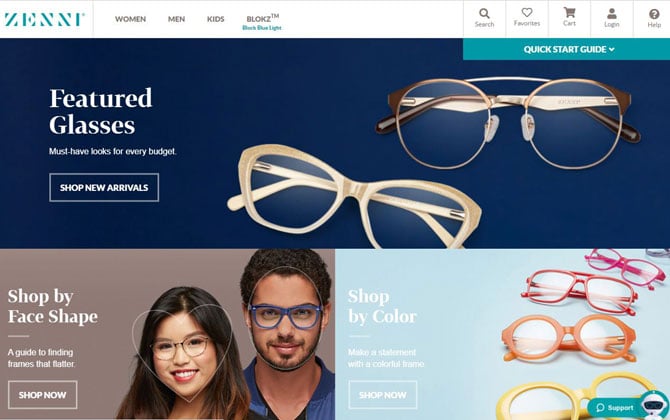
Best affordable glasses: Zenni Optical
Primary selling point: Zenni makes its own frames, and offers among the lowest prices on a pair of glasses.
Our favorite discount online eyeglasses store, Zenni Optical makes and sells the widest variety of low-cost frames of any store we surveyed. There are more than 100 sub-$10 and more than 500 sub-$20 choices, as well as sub-$75 options with progressive lenses, all without forcing you to search for special discounts. All frames come with basic prescription lenses that have an anti-scratch coating and UV protection. Zenni's lens and coating choices can be a bit overwhelming, however.
Main drawbacks: Dizzying number of often confusing lens and coating options
Frames choice: men, 895; women, 1,242; children, 143; sports, 18
Virtual try-on: yes
Contact lenses: no
Blue-light filtering option: yes
Return policy: 30-day return for 50% refund to credit/debit card or PayPal or 100% one-time-use store credit (unless defective); shipping fees not refunded
Price with basic lenses: $7–$46 (includes include anti-scratch coating and UV protection)
Price of Multifocal lenses: starting at $28
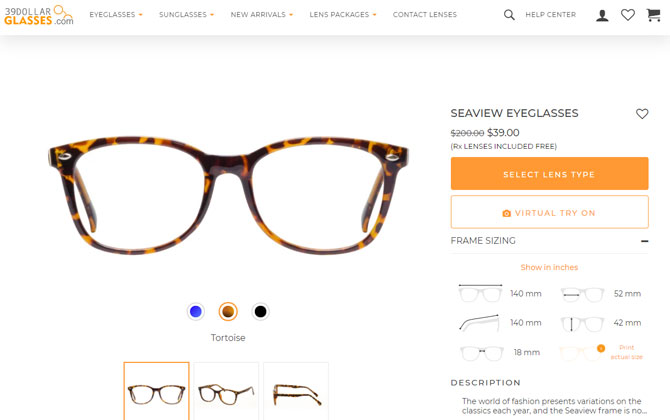
Best for refitting old frames: 39dollarglasses
Primary selling point: This is the only site we found that lets you "re-lens" — refit your old frames with new lenses, and it also sells contact lenses. UV coating is included.
Frames at 39dollarglasses — which was developed by eye doctors — start at $39 and that's where the bulk come in at. The basic distance or reader lenses that come with the frames all come with a UV coating, but multi-vision lenses are more expensive than at other sites.
The real reason to shop at 39dollarglasses.com is to buy new lenses for your old favorite frames, ultimately saving you money. You'll just need a second pair to tide you over until your refitted glasses arrive, or 39dollarglasses also sells contact lenses.
Main drawbacks: Ridiculous and distracting price-slash display — $200 cut to $39? Really? Small selection of frames. The multifocal and coatings options are slightly pricier than on other sites
Frames choice: men, 105; women, 129; children, 23; sports, 0
Virtual try-on: yes
Contact lenses: yes
Blue-light filtering option: yes
Return policy: 30-day full refund, no questions asked; 90-day exchange/store credit
Price with basic lenses: $39–$69 (includes include anti-scratch coating and UV protection)
Price of multifocal lenses: starts at $80
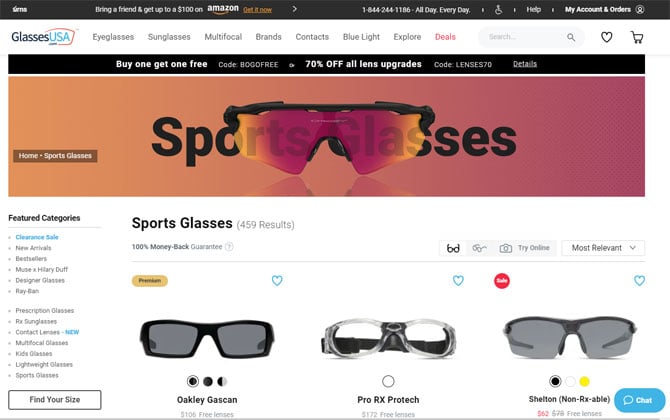
Best for sports glasses: GlassesUSA
Primary selling point: Huge variety of glasses for sports as well as regular glasses and sunglasses
GlassesUSA offers a huge selection of fashionable sports frames priced from $38 - to $110, as well as hundreds of regular frames and sunglasses. In addition to regular sports frames, you can choose from sports safety glasses, goggles, kids styles and, of course, sunglasses. The site charges $29 for standard anti-scratch, anti-reflective and UV protective lenses and you can upgrade to more impact-resistant lenses for an extra $69. And for sunglasses, you can choose a polarized lens in three colors or a tinted lens in nine different shades, as well as the gradient and darkness level. And either sunglasses lens can be mirrored in red, blue, gold, green, or silver.
Main drawbacks: Frames and lenses tend to be more expensive than the others on this list. Short return policy.
Frames choice: men, 824; women, 1114; children, 0; sports, 460
Virtual try-on: yes
Contact lenses: yes
Blue-light filtering option: yes
Return policy: 14 days, no questions asked; if your glasses break in the first year (not accidental damage or wear and tear), you get a 50% store credit towards another pair of glasses.
Price with basic lenses: $38–$750
Price of Multifocal lenses: $169
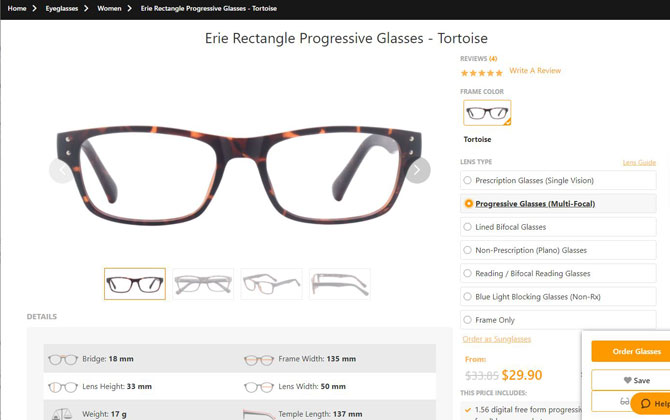
Best for budget multifocal lens glasses: Payne Glasses
Primary selling point: Super-low prices multifocal lenses and prices include anti-scratch/UV/anti-reflective lenses.
Payne Glasses manufacturers frames for itself and, seemingly, for others, so its prices are super-low and include anti-scratch/UV/anti-reflective lenses. And if you have a multifocal prescription, the lenses are low-cost as well. There's a wide variety of frames to choose from for adults and kids, but no virtual try-on.
Main drawbacks: No virtual try-on
Frames choice: men, 250; women, 354; children, 51; sports, 6
Virtual try-on: no
Contact lenses: no
Blue-light filtering option: only for non-prescription glasses
Return policy: 50% refund (excluding shipping) or 100% store credit (excluding shipping) unless defective for glasses with prescription lenses, $1.95 restocking fee for non-prescription glasses
Price with basic lenses: $6–$36 (includes include anti-scratch coating and UV protection)
Price of Multifocal lenses: $24
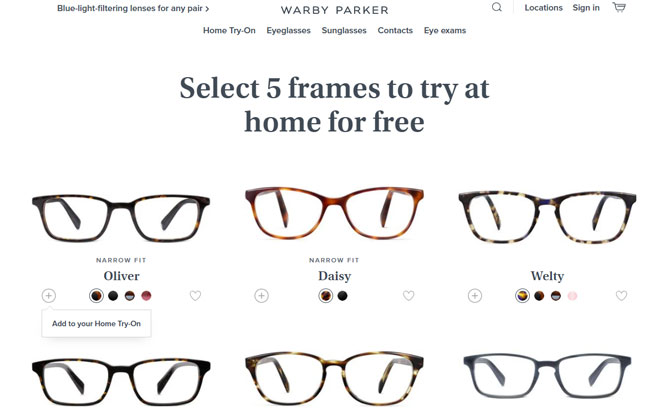
Best for try-before-you-buy: Warby Parker
Primary selling points: Get five frames sent to you to try on at home; approximately 120 physical locations in U.S. and Canada.
While not exactly a bargain shop (not even close), Warby Parker is unique in the eyeglass world — it operates not only an online site but around 120 physical retail locations. This virtual/real combo means you gain all the advantages of both types of shopping for try-on, adjustments and returns/exchanges. Even more uniquely, in addition to virtual try-on using the Warby Parker app (for iOS only on iPhone X and later models), Warby Parker will send up to five of its fashion-forward frames to your home for you to try-on — and they pay for shipping both ways (although not all frames are available for home try-on). The trade-off is that Warby Parker's frames are more expensive than those on the other sites we've listed here, although not as expensive as frames found on premium online eyeglass sites or the physical stores you've been over-paying at (until now).
Main drawbacks: Limited virtual try-on, pricier frames than other discount sites, no price filters, no prices listed until you click on a pair, progressive lenses a whopping $200 higher than single-vision lenses
Frames choice: men, 70 (many come in multiple colors); women, 78 (many come in multiple colors); children, 0; sports, 0
Virtual try-on: Yes, using the Warby Parker app for iOS and an iPhone X or later model
Contact lenses: Yes
Blue-light filtering option: Yes
Return policy: 30-days, no questions asked; will replace lenses if scratched in the first year
Price with basic lenses: $95–$195 (includes include anti-scratch, anti-reflective coatings and UV protection)
Price of Multifocal lenses: $200
Updated on 9/28/2020 with current site information and new picks.
[Image credit: Stewart Wolpin/Techlicious, Warby Parker, Payne Glasses, GlassesUSA, 39dollar Glasses, Zenni Optical]




















From Susan L Curtin on July 19, 2018 :: 7:41 pm
Yes, I have been using Zenni Optical for about fifteen years!!! I am pleased with the quality and style. I usually buy two pairs. One for residing in my purse, and one for using in the house.
I have used the photo feature as well.
You are right, there are an amazing number of frame choices.
Hope everyone will give it a try.
Reply